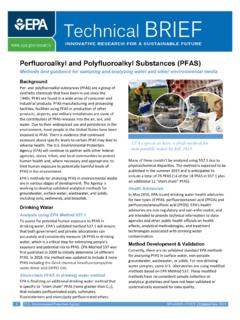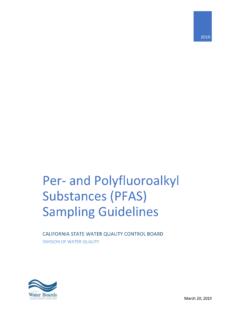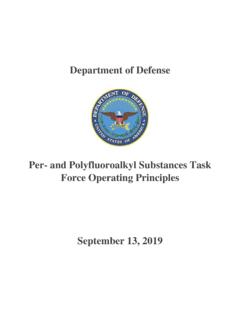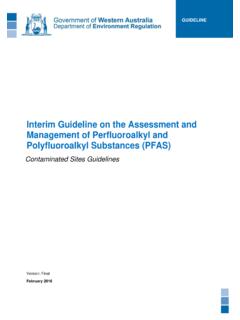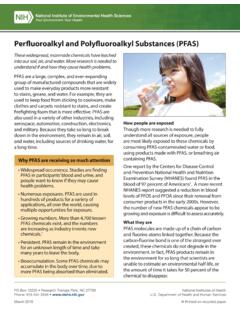Transcription of Per- and Polyfluoroalkyl Substances (PFAS) Laboratory ...
1 Association of State Drinking Water Administrators PFAS Lab Testing Primer (Version 2). Per- and Polyfluoroalkyl Substances (PFAS) Laboratory Testing Primer for State Drinking Water Programs and Public Water Systems This document provides guidance and an overview of options and issues for state drinking water programs that are associated with testing for Per- and Polyfluoroalkyl Substances (PFAS) in water samples collected from public water systems. The document provides information on: 1) Selecting an analytical method;. 2) Finding a qualified Laboratory ;. 3) Specifying a list of compounds and the form that each PFAS needs to be reported in;. 4) Specifying reporting limits;. 5) Technical issues that cause variability in testing results;. 6) Sample collection procedures.
2 7) Interpreting results; and 8) USEPA's ongoing work to develop new analytical methods Topic 1: Selecting an Analytical Method Different laboratories provide different options for measuring PFAS in drinking water. These include: 1) EPA Method 537 Rev. - Determination of Selected Perfluorinated Alkyl Acids in Drinking Water by Solid Phase Extraction and Liquid Chromatography/Tandem Mass Spectrometry (LC/MS/MS)(2009);. 2) EPA Method Determination of Selected Per- and Polyfluorinated Alkyl Substances in Drinking Water by Solid Phase Extraction and Liquid Chromatography/Tandem Mass Spectrometry (LC/MS/MS). Version (2018); and 3) Determination of PFAS Using Isotope Dilution - The name of the lab method varies from Laboratory to Laboratory . Although this lab method is completely different from EPA Method 537 Rev.
3 , some laboratories refer to their isotope dilution method as EPA 537 modified.. Both analytical methods provide reliable results if a qualified Laboratory is used. However, the water system should follow any requirements or guidance from their state drinking water program, as some individuals and entities have expressed varying preferences over which analytical method to use. Comparing USEPA Method 537 Rev , USEPA Method and Isotope Dilution Until USEPA issued Method in November of 2018, USEPA Method 537 Rev and was the only analytical method approved by USEPA and provided a single verified methodology that can be used by any Laboratory . The use of consistent methodologies among laboratories is desirable because it reduces variability introduced by using alternative analytical methods.
4 The method guidelines February 14, 2019. Association of State Drinking Water Administrators PFAS Lab Testing Primer (Version 2). provide some flexibility in the liquid chromatography tandem mass spectrometry (LC-MS/MS). This flexibility could optimize certain aspects of the method, such as column chemistry, gradient profile, and MS/MS transitions. However, USEPA Method 537 currently only applies to fourteen compounds and is only applicable to a drinking water matrix. While the cost per sample can vary, the cost per sample analyzed via USEPA Method 537 is typically $175-$275 per sample and is generally 25%-50%. less than the cost per sample analyzed via isotope dilution. In November 2018, USEPA issued Method which updates Method 537 Rev to test for an additional four PFAS in drinking water, including the GenX chemical hexafluoropropylene oxide dimer acid (HFPO-DA), 11-chloroeicosafluoro-3-oxaundecane-1-su lfonic acid (11Cl-PF3 OUdS), 9- chlorohexadecafluoro-3-oxanone-1-sulfoni c acid (9Cl-PF3 ONS), and 4,8-dioxa-3H-perfluorononanoic acid (ADONA)].
5 USEPA Method also achieves lower reporting and detection limits than USEPA. Method 537 Rev As USEPA Method was just recently released, very few commercial laboratories are accredited for or utilize this method at this time. The cost per analysis will likely be slightly higher than Method 537 Rev. Isotope dilution analytical techniques are generally considered to be the best analytical approach for PFAS for drinking water and other media. This method would probably be recommended by more regulatory agencies if there was an USEPA approved method that could be used by all laboratories. Samples that are analyzed by isotope dilution are spiked with a known amount of isotopes that are substantially the same as each of the PFAS being analyzed. The water sample is then analyzed and the concentration of the PFAS compound and the added isotope is estimated using standards for each compound.
6 If the measured concentration of isotope that was added to the sample is above or below the actual amount added, the PFAS result is corrected by a proportional amount. The benefit Method Comparison Study - New Hampshire of making the correction is that the analysis can Department of Environmental Services (NHDES) account for analytical errors associated with the matrices of the samples. Water samples possess NHDES conducted a split sample study on water chemical and physical properties other than just the samples collected from private and public water concentration of PFAS, and these properties can systems. The water samples were analyzed by the same Laboratory using both isotope dilution alter the response of the instrument that is and Method 537. The measured concentration measuring PFAS and produce errors.
7 Isotope of PFAS samples analyzed by Method 537 and dilution corrects for matrix interferences or errors. isotope dilution were similar, meaning that For this reason, isotope dilution is often utilized on matrix interference was not an issue for the other media such as wastewater, solids and samples that were included in this study. groundwater samples. USEPA Method Field Blanks and USEPA Method 537. It is important to note, that EPA Method 537 Rev requires water systems to collect a field blank at each sampling location. This requirement addresses the concern that the sample collection process could introduce PFAS contamination because of the ubiquitous nature of these compounds in the environment coupled with the part-per-trillion reporting limits that are utilized. Collection of QA/QC.
8 (field blank, trip blank, and method blank) samples can be useful to assess field contamination from February 14, 2019 2. Association of State Drinking Water Administrators PFAS Lab Testing Primer (Version 2). materials such as Tyvek PPE that might include PFAS residues. However, with sound sampling protocols, PFAS are not routinely detected in field blanks associated with the sampling of public water systems. This means that the sample collection process is not regularly introducing contaminants into the water sample and thus a field blank only needs to be collected when there is a detection in a corresponding sample. Some laboratories performing EPA Method 537 Rev. continue to request a field blank with each water sample and charge for both the drinking water sample and the field blank sample which may double the overall cost.
9 The cost of running the field blank should be included in the cost of the analysis, not added on for each field blank sample. Topic 2: Finding a Qualified Laboratory A water system should check with their state drinking water program to see if their state has established a list of approved, certified or accredited laboratories for completing PFAS analyses. If the state has not established a list, water systems can identify laboratories that have been accredited by: 1) National Environmental Laboratory Accreditation Program ( ) by selecting a common PFAS chemical such as perfluorooctanoic acid (PFOA) under the Analyte pulldown tool; and 2) The Department of Defense by selecting EPA 537 or EPA 537 Mod under the Method pull down tool. The laboratories that water systems routinely do business with may already have or can establish subcontracts with laboratories listed with the two accreditation programs.
10 State drinking water programs should also consider the advantages and challenges associated with using state laboratories. Topic 3: Which PFAS Chemicals Should Be Analyzed? A water system should check with their state drinking water program to see if their state has established a list of PFAS compounds that should be analyzed for. There are thousands of PFAS. compounds. Commercial laboratories can typically analyze for only approximately 6 to 30. compounds. A Laboratory may offer multiple options on the number of PFAS compounds that will be reported. If EPA Method 537 is utilized, as many as 14 compounds may be included. If lab methods based on isotope dilution are utilized, the number of compounds could approach 30. Generally, the cost per sample increases when more compounds are measured.




